THIRTY YEARS RUNNING
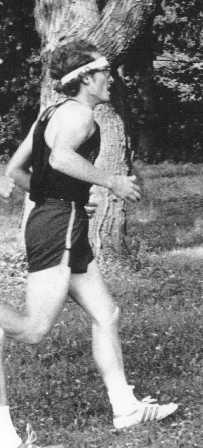 My days as a competitive runner began in 1972 May,
thirty years ago.
I did some training before that to run faster in gym class
or because it was fun to jog along the beach,
but I made a decision to be a runner in 1972 May,
when I went out for the cross country team.
My days as a competitive runner began in 1972 May,
thirty years ago.
I did some training before that to run faster in gym class
or because it was fun to jog along the beach,
but I made a decision to be a runner in 1972 May,
when I went out for the cross country team.
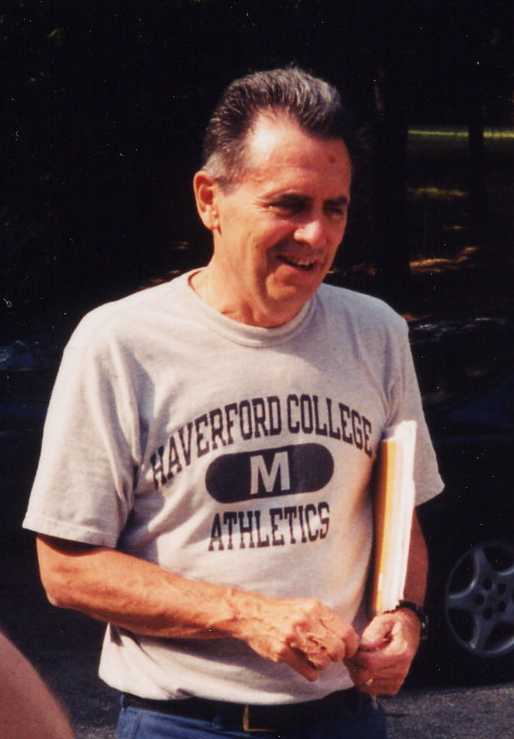 It started out as a bet.
I was on the nerdy-fat-kid side of the table
making fun of the gaunt cross-country fellows
and one named Bob said,
"At least I'm in shape.
I'll bet you a quarter that you can't even run an eight minute mile."
The bet was on,
the side bets piled high,
and my time of 7:35 earned me forty cents that day.
I went running after school a few more times
and a desperate coach,
Tom Sexton,
recruited me for the Cheltenham Cross Country team.
I managed to go from Junior Varsity on a 0-14 team
(that's zero wins and fourteen losses)
to being fifth runner Varsity on a 6-6 team.
It started out as a bet.
I was on the nerdy-fat-kid side of the table
making fun of the gaunt cross-country fellows
and one named Bob said,
"At least I'm in shape.
I'll bet you a quarter that you can't even run an eight minute mile."
The bet was on,
the side bets piled high,
and my time of 7:35 earned me forty cents that day.
I went running after school a few more times
and a desperate coach,
Tom Sexton,
recruited me for the Cheltenham Cross Country team.
I managed to go from Junior Varsity on a 0-14 team
(that's zero wins and fourteen losses)
to being fifth runner Varsity on a 6-6 team.
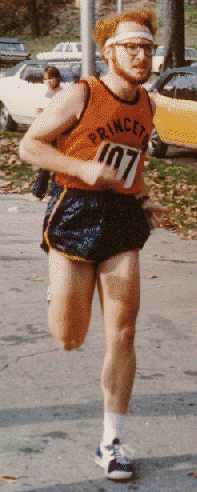 I managed to run a three mile cross country course in 17:45
and track times of 5:12 for one mile
and 11:01 for two miles.
My mailbox was not stuffed with
letters from college track coaches.
But I learned to enjoy the sport
and I even won a two-mile race once.
I managed to run a three mile cross country course in 17:45
and track times of 5:12 for one mile
and 11:01 for two miles.
My mailbox was not stuffed with
letters from college track coaches.
But I learned to enjoy the sport
and I even won a two-mile race once.
When I got to Princeton,
I was quickly outclassed by a team that would put
five runners under 25:00 for five miles that year.
They said, "Why don't you run with the slow half-milers?"
So I asked the slow half-milers how slow they were:
Jeff Weiksel had run 1:53,
Charlie Norelli had run 1:51,
and Craig Masback had run 1:49.
Those times didn't sound slow to me.
So I ended up training for the marathon.
During my college years I ran four marathons
ranging from 3:12 to 3:03.
Boston in 1975 April
was the most painful as I went out way too fast,
ten miles in an hour, and dragged it home on bloody feet in 3:09.
I ran the New York City Marathon
the first year it was all five boroughs, 1976 October,
in 3:03:30.
That works out to 6:59.9 per mile and I don't
round it off to seven minutes.
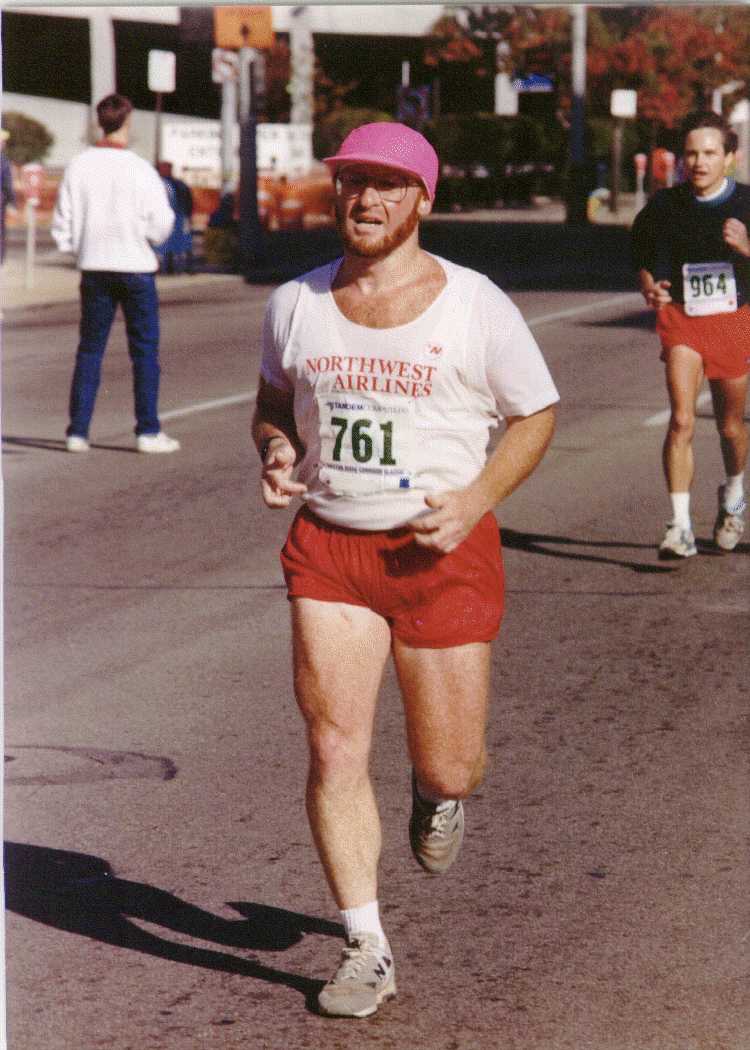 Well, my running has had some slower times
and some faster times along the way.
In 1991 I enjoyed a renewed enthusiasm
and got into good enough shape to run 3:28:45
at the Glass City Marathon
and 94:30 at the Dayton River Corridor Classic Half Marathon.
Well, my running has had some slower times
and some faster times along the way.
In 1991 I enjoyed a renewed enthusiasm
and got into good enough shape to run 3:28:45
at the Glass City Marathon
and 94:30 at the Dayton River Corridor Classic Half Marathon.
In hindsight,
I did something very smart as a youth.
I never ran a 5K or 10K for time,
so my personal records (PRs) are very "soft,"
21:02 for 5000 meters and 42:30 for 10 Km.
Running that dumb race at Boston
I probably went through 5000 meters under 18:00
and 10,000 meters in 37:00,
but those weren't 5K or 10K races
so they don't count.
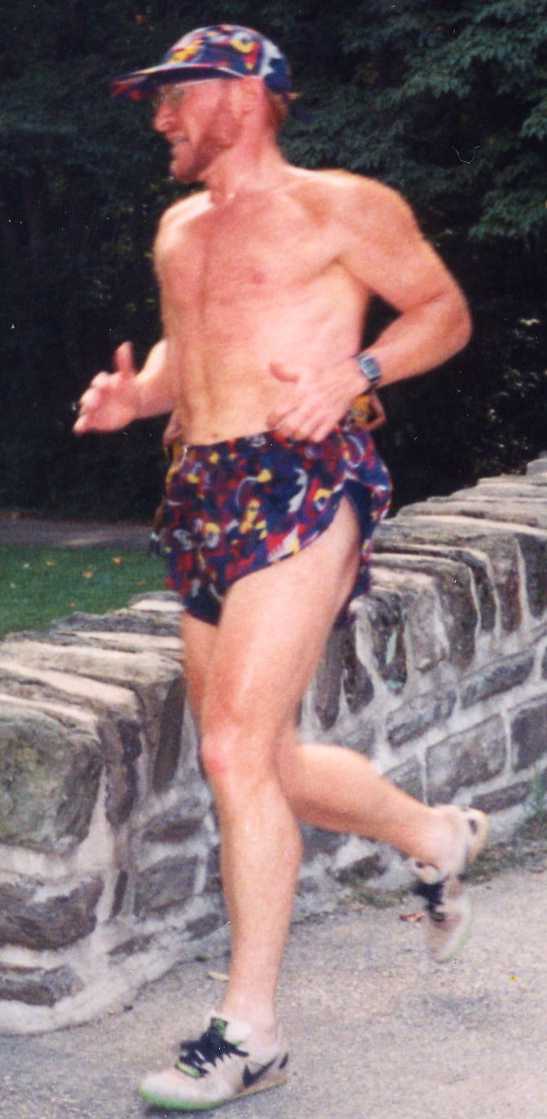 Well, here it is three decades later and I'm still out there,
just doing it.
I am one of two Cheltenham Cross Country members
who has run all sixteen Alumni vs. Varsity races.
In 2001 December I ran my thirteenth marathon
and I have been lucky enough to finish
every marathon I started.
I agree with Ron Hill that it is smart to wait long enough
between marathons that you forget what the last one felt like.
Based on 20:02 for three miles cross country
and a recent 99:05 half marathon,
I expected to run Lucky Thirteen in 3:30
rather than 3:53, but, hey,
I got to the finish line in one piece.
And there's always next year.
Well, here it is three decades later and I'm still out there,
just doing it.
I am one of two Cheltenham Cross Country members
who has run all sixteen Alumni vs. Varsity races.
In 2001 December I ran my thirteenth marathon
and I have been lucky enough to finish
every marathon I started.
I agree with Ron Hill that it is smart to wait long enough
between marathons that you forget what the last one felt like.
Based on 20:02 for three miles cross country
and a recent 99:05 half marathon,
I expected to run Lucky Thirteen in 3:30
rather than 3:53, but, hey,
I got to the finish line in one piece.
And there's always next year.
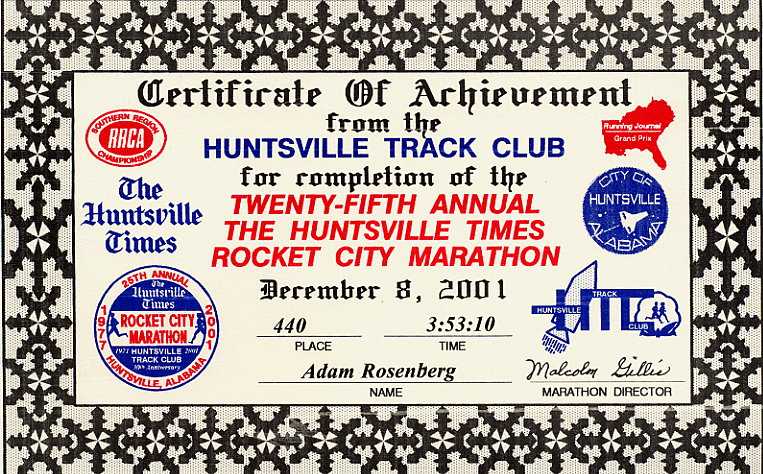 My views on training are decidedly old-fashioned.
As my high school track coach, Doug Scott, said many times,
there is no guarantee that working hard and being tough
will win races.
But I can guarantee that goofing off and wimping out
will not.
My views on training are decidedly old-fashioned.
As my high school track coach, Doug Scott, said many times,
there is no guarantee that working hard and being tough
will win races.
But I can guarantee that goofing off and wimping out
will not.
First of all, mileage matters.
Notice that the guys who preach moderation in mileage
are guys who ran Olympian times with Olympian mileage,
typically 140 to 170 miles per week.
When they preach mileage reduction,
from 140 to 110 miles per week,
listen and learn.
But that is not a mandate for the rest of us
to back off from 35 to 20 miles per week.
At my advanced and advancing age,
I consider an 80 mile week a major triumph,
and I did a few of them in my recent marathon training.
It is important to get the long runs in, too,
those Sunday morning twenty milers.
It is a wonderful paradox of human physiology
that running easy, slow, and long makes one better
at running hard, fast, and short.
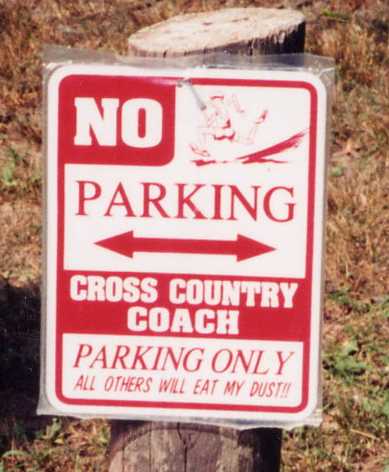 Long, slow distance isn't all of it, however.
There has to be some quality in there, too.
Interval training,
short, painful bursts of intensity with rests in between,
is a requirement for seeing good race times.
One should throw in some tempo runs as well,
continuous, hard runs of one to two hours.
The training should be mostly lazy and slow
with occasional pushes up hills
or Fartlek bursts of speed between telephone poles,
but the good, hard, tough stuff has to be there.
If nothing else,
hard training prepares a runner for hard racing.
Long, slow distance isn't all of it, however.
There has to be some quality in there, too.
Interval training,
short, painful bursts of intensity with rests in between,
is a requirement for seeing good race times.
One should throw in some tempo runs as well,
continuous, hard runs of one to two hours.
The training should be mostly lazy and slow
with occasional pushes up hills
or Fartlek bursts of speed between telephone poles,
but the good, hard, tough stuff has to be there.
If nothing else,
hard training prepares a runner for hard racing.
You may argue that there is more to running than racing well.
I certainly would, and I have made that argument several times.
But it sounds a lot more convincing,
and a lot less like sour grapes,
when the racing is going well.
Another way of looking at it is this:
I have raced faster and I have raced slower,
and I can tell you that faster is better.
The sport of running has been good to me
and I certainly enjoy it more when I do it better.
THE ADAM HOME PAGE
adam@the-adam.com
 My days as a competitive runner began in 1972 May,
thirty years ago.
I did some training before that to run faster in gym class
or because it was fun to jog along the beach,
but I made a decision to be a runner in 1972 May,
when I went out for the cross country team.
My days as a competitive runner began in 1972 May,
thirty years ago.
I did some training before that to run faster in gym class
or because it was fun to jog along the beach,
but I made a decision to be a runner in 1972 May,
when I went out for the cross country team.





